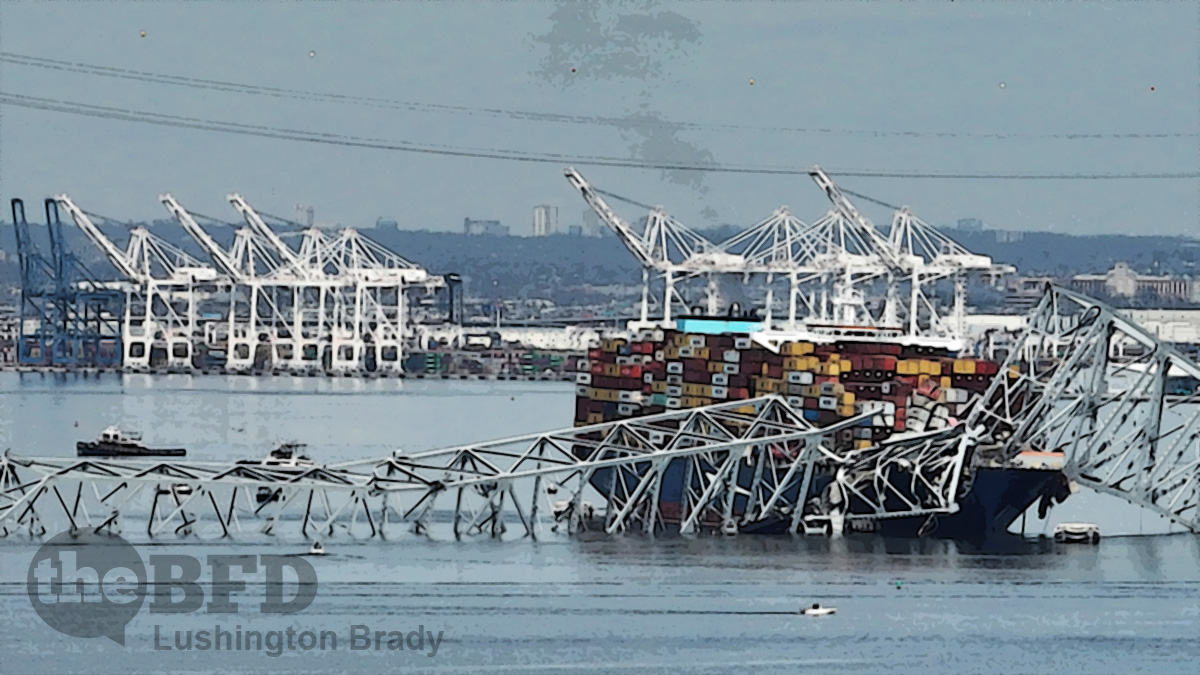Opinion
When the shocking video of the collapse of the Francis Scott Key Bridge in Baltimore broke, many Australians were immediately reminded of Hobart’s Tasman Bridge disaster in 1975. In that disaster, twelve people were killed when an off-course bulk freighter struck the bridge, causing a section to collapse.
As it turns out, Australians have another good reason to feel a sense of deja vu.
Another ship owned by the same company was detained and banned from Australian ports for six months in 2021 over “serious and shameful” labour violations.
A safety probe will include whether contaminated fuel played a role in the cargo ship losing power, the Wall St Journal reports. The eight year old ship was reported last June to have propulsion deficiencies and is owned by a company cited by Australian authorities for labour abuses.
The 300m-long, 95,000 tonne ship, managed by Singapore-based Synergy Marine, was carrying 4679 containers for Danish shipping giant Maersk and was being controlled by two Baltimore port pilots when it rammed the 2.5km steel arch bridge, causing it to crumple into the icy waters.
The good folk of Antwerp, too, have good reason to sense something very familiar about all this.
The 2015-built Dali hit a dock in the Belgian port of Antwerp in 2016, as it was trying to exit a container terminal.
An inspection of the vessel reported a structural issue, stated as “hull damage impairing its seaworthiness,” Reuters reports.
In Australia, the ship owners were cited by Australian authorities, and one of its fleet banned from Australian ports.
As investigators try to determine the cause of the accident, attention is turning to alleged labour abuses by Dali owner Grace Ocean, a Singapore-based company variously reported to be a subsidiary of Japanese conglomerate Mitsui or a Hong Kong group.
Grace Ocean was cited by the Australian Maritime Safety Authority for “serious and shameful” labour violations in 2021 after of its ships, Western Callao, was detained over the underpayment of 13 crew who had been kept on board for more than 12 months, well beyond their nine-month contracts, The New York Times reported. The ship was banned from Australian ports for six months. A year earlier, Australian inspectors found eight sailors on the same ship had been on board for more than 11 months, while another Grace Ocean-owned vessel, Furness Southern Cross, had 10 seafarers on board for more than 14 months.
Chilean officials last year filed a report on the Dali which, in retrospect, carried an ominous warning for Baltimore.
Grace Ocean owns 55 ships, according to Equasis, a public database which revealed the Dali was reported on June 27, 2023 by port officials in San Antonio, Chile, for a deficiency related to “propulsion and auxiliary machinery”.
The report described issues with “gauges, thermometers, etc” though the problem was not serious enough to detain the ship, and three months later a follow-up inspection by the US Coast Guard made no further mention of it.
Tuesday’s crash raises the possibility there were recurring problems with the vessel’s propulsion system – a likely focal point for the US National Transportation Safety Board which is leading the investigation. Also under scrutiny will be whether contaminated fuel played a role in the ship’s loss of power before the crash.
The Dali’s lights began flickering not long into its voyage early on Tuesday and a harbour pilot and assistant reported power issues and a loss of propulsion before the crash, according to a Coast Guard briefing viewed by The Wall Street Journal. “The vessel went dead, no steering power and no electronics,” a ship’s officer said. “One of the engines coughed and then stopped. The smell of burned fuel was everywhere in the engine room and it was pitch black.”
Expect lots of arguing back-and-forth over who is ultimately responsible for the multi-billion dollar bill, not to mention the loss of life. So far, it seems likely that Grace Ocean, the ship owner will bear much of the blame, but it likely won’t end there.
As the Dali’s flag state, Singapore is responsible for enforcing relevant safety standards for the vessel and must by law conduct an inquiry into the accident. The Maritime and Port Authority of Singapore said the ship passed two foreign port authority inspections last year. “In the June 2023 inspection, a faulty monitor gauge for fuel pressure was rectified before the vessel departed the port,” it noted.
The Australian
Maritime safety has been a hot issue for years, now. It seems the ships are finally ramming it home.

